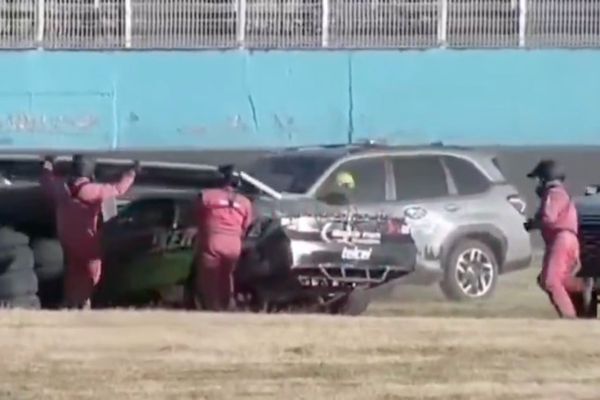
At the far end of one of the mammal rooms in the maze of offices and labs behind the Australian Museum in Sydney stand two anonymous grey metal cabinets. Although there is nothing to distinguish them from the storage units elsewhere in the room, they are freighted with particular significance.
These cupboards, known within the museum as the “extinction cabinets”, contain specimens of 24 of the 39 mammal species that have been wiped out since Europeans invaded Australia. They hold an index of loss stretching back almost 240 years.
My guide to the cabinets is Dr Mark Eldridge, a geneticist and the museum’s manager of terrestrial vertebrates. Eldridge opens the first of the cabinets to reveal 11 wide, sliding shelves, each of which contains an assortment of skins, teeth, bones and taxidermized mounts.
Some of the animals are immediately recognisable – the bottom shelves contain the striped hides of two thylacines, for instance. Others, like the stuffed form of a Koontin are less familiar.
But as Eldridge picks out each relic in turn, he relates the animals’ stories, his tone bouncing from dismay to regret and back again. One bundle of soft, blonde-brown fur is all that remains of a toolache wallaby, a species that once inhabited a small area in south-eastern South Australia. It was hunted for sport by early settlers, but is more likely to have been driven to extinction by the destruction of its habitat for farmland.
On another shelf, the stuffed forms of a Maclear’s rat and a bulldog rat sit alongside two tiny boxes containing their skulls. Both have beautiful deep reddish-brown fur; endemic to Christmas Island, both species were extraordinarily abundant when Europeans first landed and had so little fear of humans that they would invade tents in search of food. Their population collapsed in the first years of the 20th century, probably as a result of a parasitic disease borne by newly introduced black rats.
Perhaps most striking of all are the thylacine skins. “A lot of museums have a sacrificial thylacine on display so people can see it,” says Eldridge. “But they get bleached and lose their colour. So we keep the good ones that still have their natural colours and markings here.”
Indeed, these thylacines are quite different to those I have seen elsewhere; their fur darker and thicker, the stripes not black but a deep, rich, chocolate brown. One still has the pouch in which she would have reared her young: the dried husk of the nipple protrudes like a finger from the skin. Even more striking – and affecting – are the long back feet with their soft, leathery black pads.
‘Oh, this is all we have left’
The cabinets are the work of the manager of the mammalogy collection, Dr Sandy Ingleby, who took on the task of assembling them not long after she joined the museum in 1996. Initially their purpose was practical, a way of ensuring specimens that are, by their very nature, irreplaceable, were stored somewhere centralised and safe.
This is especially important because many of the species held in the cabinets disappeared so quickly that almost nothing remains of them: in the case of the broad-faced potoroo – a small marsupial that lived in southern Western Australia that is believed to have been killed off when cats arrived in the region in the second half of the 19th century – only 10 skins remain, five of them in the Australian Museum’s care.
“Sometimes it’s like looking at ghosts,” says Ingleby. “You look at them and think, ‘Oh yes, this is all we have left’.”
But as time has gone on, the cabinets have taken on meanings that extend beyond the scientific and curatorial. “People often cry when they see them,” says Eldridge. “You just open them up and start talking and when you look around they’re bawling.”
I don’t cry, but as Eldridge opens drawer after drawer I find myself increasingly overwhelmed. Partly that is because the cumulative weight of so much loss is difficult to bear, but it is also because it is difficult to know what to do with what I am feeling. Should I be sad? Angry? Guilty? What is the most appropriate – or perhaps more importantly – the most useful way to grieve the destruction of a species?
These responses are a reminder that extinction is not a purely biological process, but something far broader and more complex. Thom van Dooren is a professor of environmental science and the deputy director of the Sydney Environment Centre at the University of Sydney. He argues a narrowly scientific focus can prevent us from seeing the multidimensional network of ecological and cultural relationships every species inhabits.
For van Dooren, extinction is never a “single, sharp event”; instead it is “an unravelling of relationships that begins before and continues well after the death of that last individual”.
Understanding extinction in these terms allows it to be connected to ideas of justice, especially where the loss of a species involves the breakdown of traditional cultural practices or kinship systems. But it also opens up the possibility of thinking about extinction in ways that extend outwards, beyond what van Dooren describes as the “thin stories” we usually tell about the loss of species and towards more meaningful forms of commemoration and mourning.
The question of how we might tell better stories about extinction lies at the heart of Survival Stories, a new project conceived by Dr Zoe Sadokierski, an associate professor in the school of design at the University of Technology Sydney. Incorporating text, images, animations and even performance, Survival Stories aims to help audiences find new ways to think about environmental crisis and extinction.
Sadokierski sees the project as “a way of bearing witness. But it’s also about finding a way to make something so immense and overwhelming feel tangible.” For Sadokierski, that means creating works that help people relate to the animals in the cabinets, and by extension other animals that are not yet extinct.
“Finding ways to make that human-animal connection is so important, because it helps people see that we’re not separate from them,” she says.
Developing conceptual and emotional tools to articulate the often inchoate sense of grief we feel in the face of the loss of a species can do more than help us reckon with the past. It can also help us think more effectively about the threats many species face, both now and in the future.
“The thylacine story isn’t just about the thylacine,” says van Dooren. “It’s a story about the practices of sheep farming and bounties and agricultural practices that are complicit in so many extinctions not just in the past in Tasmania, but as an ongoing phenomenon.”
‘I thought nothing more would be added’
There is an urgent need for people to make these connections. When Ingleby began work on the cabinets almost 30 years ago, she assumed they would be a finite project. “I thought we’d learned our lesson, and nothing more would be added. But of course that hasn’t been the case.”
Recent additions to the melancholy roll call of species contained in the cabinets include the Christmas Island pipistrelle, a tiny bat that was declared extinct in 2009, and the Bramble Cay melomys, a rodent which became the first mammal to be wiped out by climate change when the coral cay from which it takes its name was submerged by rising sea levels sometime between 2009 and 2015.
Nor are the pipistrelle and the melomys likely to be the last animals added to the cabinets, or indeed to similar cabinets in the bird and reptile collection. As well as the 70 species of animals known to have been driven to extinction in Australia, another 55 are classified as endangered or critically endangered.
And this process is accelerating. A 2022 study of the 63 most at-risk Australian vertebrates found four were almost certainly already extinct, 12 were possibly extinct and nine were more likely than not to become extinct in the next 20 years.
Despite this mounting death count, Australian governments have repeatedly failed to take meaningful action to slow the decline of native species. Most recently, the federal environment minister, Tanya Plibersek, said Australia’s environment laws are “broken” and promised regulatory changes to prevent future extinctions.
But despite positive steps that include the creation of new agencies charged with monitoring and enforcing environmental regulations, new funding to help assist threatened species and the rejection of projects such as the Toondah wetlands development, in April she indefinitely delayed plans for new laws to protect threatened species and ecosystems – reportedly as a result of pressure from the Western Australian government and the mining industry.
Eldridge says he finds government inaction frustrating, not least because the drivers of extinction are well understood: along with widespread destruction of habitat and the rapidly intensifying challenge of climate change, it seems almost every animal he shows me was the victim of cats and foxes.
“We know what to do, and we know that when we spend money on threatened species we can turn things around,” he says. “It’s about tackling loss of native habitats, it’s tackling introduced species and waste and climate in a serious way. But that’s clearly not a priority for the government or for the Australian people.”
Ingleby agrees. “I open that cabinet all the time and it never gets any easier,” saysshe says. “It’s a constant reminder of how irresponsible we’ve when it comes to valuing the native mammals in Australia.”







